10 Types of Hummingbirds in Arkansas (With Pictures)
Last Updated on
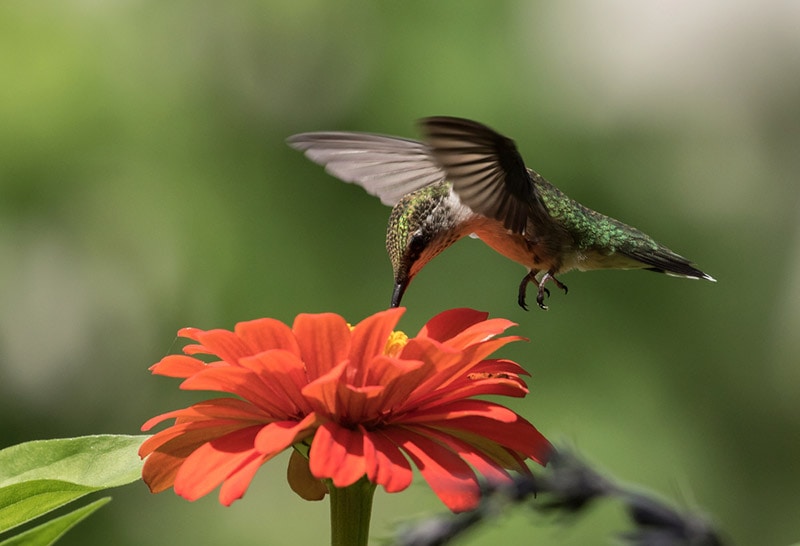
According to the American Bird Conservancy, there are a total of 365 hummingbird species in the Americas. 15 of them are considered native in the United States (and pretty common), and 9 of the remaining 350 occasionally visit for various reasons.
The hummingbird species is a special type of breed. Their shoulder joints are usually very flexible, thus giving them the ability to rotate their wings at a 180-degree angle. And that is why hummingbirds are the only vertebrae capable of hovering mid-flight, making you think they are just floating in the air.
The most common hummingbird in Arkansas is the Ruby-Throated species. Just like the residents, it has certainly fallen deep in love with the state’s scenic rivers, towering forests, and gorgeous mountains. Let’s first talk about the Ruby, and then move on to the other hummingbird species that like to visit.

The 10 Hummingbird Species in Arkansas
1. Ruby-Throated Hummingbird

| Wingspan: | 3.1–4.3 in (8–11 cm) |
| Length: | 2.8–3.5 in (7–9 cm) |
| Weight: | 0.1–0.2 oz (2–6 g) |
Ruby-Throated Hummingbirds are the only hummingbird species that breed in eastern North America. They are frequently spotted in Arkansas during summer, as opposed to winter, when their food stores are gravely depleted. By the way, these birds enjoy feeding on nectar more than anything else. That’s why you keep seeing them hovering above epiphytes, brightly colored flowers, and shrubs.
Distinguishing the males from the females is not that hard of a task. The males have forked tails and emerald-green backs, besides the gorget that’s always iridescent ruby-red. The females also possess a gorget, but theirs is plain with faint dusky streaks. You’ll take note of the fact that they aren’t as brightly colored as their male counterparts, as they have backs that are dull green.
2. Anna’s Hummingbird

| Wingspan: | 4.7 in (12 cm) |
| Length: | 3.9 in (10 cm) |
| Weight: | 0.1–0.2 oz (3–6 g) |
The Anna is also a fairly common hummingbird species in Arkansas. And you’ll know when it comes to visit you because it’s very vocal.
The males are very territorial, and you’ll know you’ve spotted a male Anna if its plumage seems glossy, with iridescent emerald-green feathers. Depending on the lighting, their necks, throats, and crowns will appear slightly orange or pinkish red.
Male juveniles are different since the color of their plumage is very similar to that of the adult female. That’s to say, they both have gorgets with white or red spots and a greenback. It’s easy to miss this, but a keen observer will again realize that the tip of their tails is always white.
3. Rufous Hummingbird
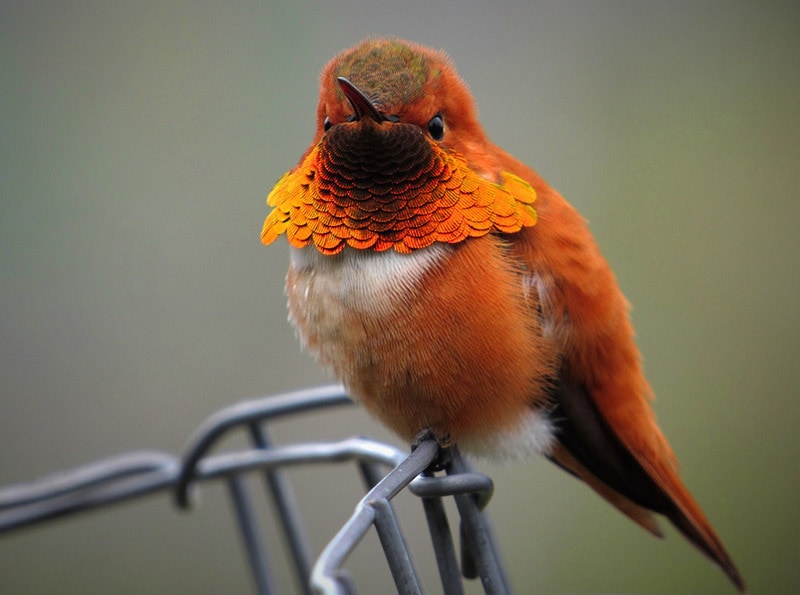
| Wingspan: | 4.3 in (11 cm) |
| Length: | 2.8–3.5 in (7–9 cm) |
| Weight: | 0.1–0.2 oz (2–5 g) |
“Rufous” has often been used in the ornithology community to describe the plumage of various animals, especially birds. This word was borrowed from the Latin word “Rufus”, which loosely translates to “reddish”. And that’s exactly what the Rufous Hummingbird is—a reddish bird.
The females are always larger than males and have a few spots of orange on their throats. But unlike the males, instead of a reddish (rufous) crown, they have a green one.
We would never describe the Rufous as social, given they like to attack other birds. Of course, they are not crazy enough to go after a hawk or eagle, but we’ve seen them attack other hummingbirds. They’ve also been spotted, on several occasions, dive-bombing humans who were trying to invade their personal spaces.
Rufous Hummingbirds have been blessed with extendable tongues that are very useful when it comes to sucking nectar from tubular flowers. They won’t hang around during winter, even if it means traveling across the country.
4. Black-Chinned Hummingbird
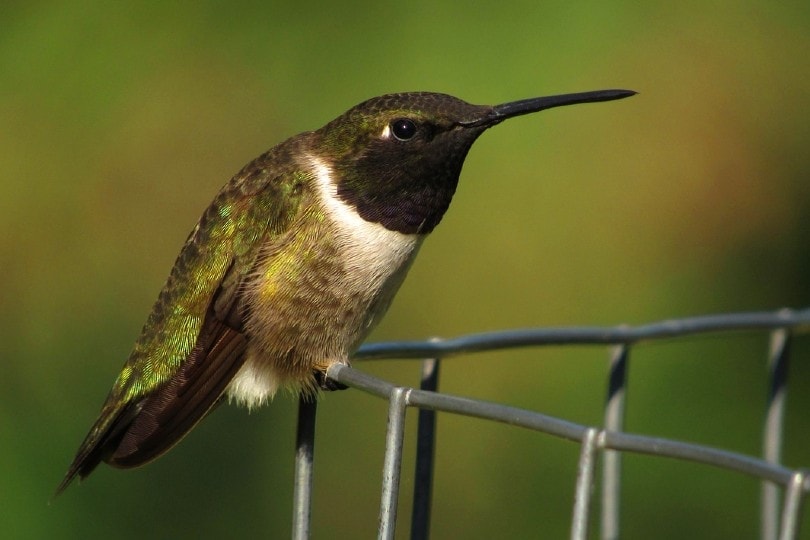
| Wingspan: | 4.3 in (11 cm) |
| Length: | 3.5 in (9 cm) |
| Weight: | 0.1–0.2 oz (2.3–4.9 g) |
The Black-Chinned Hummingbird, sometimes referred to as the Alexander Hummingbird, was first discovered in Mexico. It’s easy to confuse this species for the Coast, Broad-Tailed, Lucifer, or Anna’s hummingbird because it often hybridizes with them.
It’s been established that this species has the ability to detect ultraviolet light and boasts an acute sense of hearing. What’s more, it’s not considered a picky eater, since it doesn’t care about the source of the nectar it feeds on. That’s probably the reason why they are known to easily adapt to any habitat.
They are called “Black Chinned” because they all have a black chin. They are not as common as other hummingbirds in Arkansas.
5. Broad-Tailed Hummingbird

| Wingspan: | 5.25 in (13 cm) |
| Length: | 3.1–3.5 in (8–9 cm) |
| Weight: | 0.1–0.2 oz (2.8–4.5 g) |
The Broad-Tailed species has physical attributes that are very similar to the Ruby-Throated Hummingbird. Their backs are usually green-gray, and the tails are rounded and black. The male has a magenta gorget, while that of the female is rose-red.
This species is not as widespread in Arkansas as it is in the Rockies. Since this region typically experiences very cold nights and hot days, the Broad-Tailed Hummingbird usually slows down its heart rate as the sun goes down, to lower its body temperature, and then ramps it back up in the morning as the sun rises.
6. Calliope Hummingbird
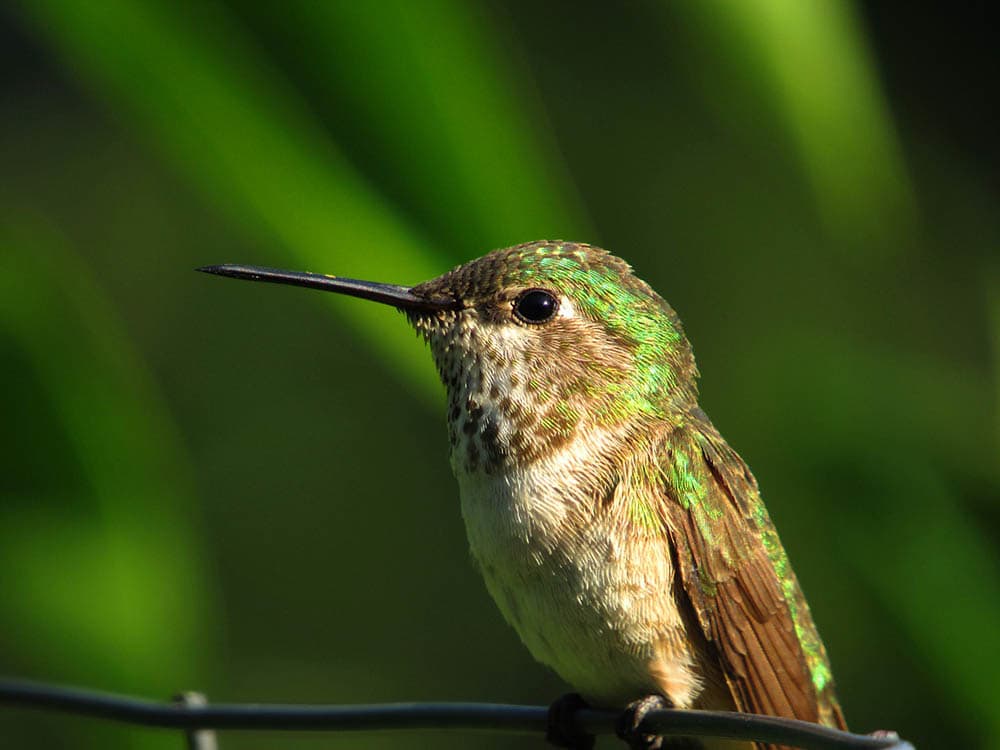
| Wingspan: | 4.1–4.3 in (10.5–11 cm) |
| Length: | 3.1–3.5 in (8–9 cm) |
| Weight: | 0.1–0.1 oz (2.3–3.4 g) |
Hummingbirds are generally small. But the Calliope Hummingbird is smaller than usual—about the same size as a ping pong ball. These birds were named after Calliope, who was considered the “Chief of all Muses”. Calliope was the source of inspiration behind the production of Homer’s Iliad and Odyssey.
The Calliope Hummingbird is naturally territorial. And they are often ready to scale up that level of aggressiveness if you invade their breeding grounds. Their tiny stature has never felt like a hindrance in the field, as they’ve been spotted attacking birds that are as big as the Red-Tailed Hawk.
You might spot one in Arkansas during summer, but not winter. Once the temperatures start dropping, they’ll pack up and migrate to Mexico. Calliopes are long-distance migrants, and they prefer breeding at elevations above 4,000 feet.
It is said that they primarily rely on nectar, but they won’t mind foraging for small insects from time to time. The Calliope’s hunting technique is known as “hawking.” It will perch on a branch that offers a clear line of sight and fly out to catch its prey in midair.
7. Broad-Billed Hummingbird

| Wingspan: | 5.1 in (13 cm) |
| Length: | 3.1–3.9 in (8–10 cm) |
| Weight: | 0.1–0.1 oz (3–4 g) |
The Broad-Billed Hummingbird only breeds in New Mexico or Arizona. And clearly, it has everything to do with the weather in those regions. Mistaking the male for the female is virtually impossible, as males all have a blueish-green belly and purplish-blue throat. Their bill, on the other hand, is reddish-orange, complimented by a black tip.
The female bill is just plain black. Their bellies appear grayish and their backs green. This species has always been considered an “accidental sighting” in Arkansas, meaning they rarely visit this incredible southern state. Of the five Broad-Billed subspecies that exist, only the magicus has inhabited the U.S.
This bird loves nectar as much as the next hummingbird, but don’t be surprised to find it foraging for insects during summer.
8. Mexican Violetear

| Wingspan: | 4.7 in (12 cm) |
| Length: | 3.8–4.7 in (9.7–12 cm) |
| Weight: | 0.17–0.2 oz (4.8–5.6 g) |
In some parts of the world, the Mexican Violetear is known as the Green Violetear. Probably because of its color, seeing as the males have an emerald-green plumage that’s glossy. Their breasts and ear patches are both violet, but the beak is black. The only difference between them and their partners is that the females tend to have a duller appearance.
This species is prevalent in Central America. You’ll never find them roosting or foraging with other bird species, and they like to feed on native plants, nectar, and small insects. Their calls usually sound a lot like “chuts”, and they are very vocal during their breeding season. If you’re living in Arkansas, you’ll only spot or hear one during summer.
9. Buff-Bellied Hummingbird

| Wingspan: | 5.75 in (14.6 cm) |
| Length: | 3.9–4.3 in (10–11 cm) |
| Weight: | 0.1–0.18 oz (2–5 g) |
As you might have guessed, the Buff-Bellied Hummingbird has an incredibly buff belly. Texans and Mexicans are well acquainted with this species, as it’s common in those regions. An ideal Buff-Bellied habitat is dry or arid. Identifying one shouldn’t be that challenging, since it has an orange-tinted plumage and a very bright red bill.
Inside that bill, there’s a very long tongue. That’s how you know it prefers feeding on nectar and only prey on insects to supplement its diet. The Buff-Bellied species is not a small hummingbird. It’s also not very social, as it’s been spotted chasing other hummingbirds.
10. Rivoli’s Hummingbird

| Wingspan: | 7.1 in (18 cm) |
| Length: | 4.3–5.5 in (11–14 cm) |
| Weight: | 0.3–0.3 oz (7–8 g) |
This bird was named after the second Duke of Rivoli, who happened to be an amateur ornithologist. However, in 1983, the ornithology fraternity decided to change the name to the Magnificent Hummingbird.
We never thought we’d ever hear the name “Rivoli’s” again, but we did in 2017. That’s when the members of the Clements taxonomy, those of the International Ornithology Committee, and those representing the American Ornithological Society decided to split Magnificent into two species. One of the species was called Talamanca Hummingbird, while the other adopted the original name—the Rivoli Hummingbird.
Just like most hummingbird species, they are migratory in nature and love feeding on nectar. The males have a bright blue-green throat, violet crown, and a white spot behind their eyes. We noted that their juveniles have similar coloration to the female, meaning they are all bronze green dorsally and have a white stripe behind the eye.
How To Lure Hummingbirds to Your Yard
Buy The Best Feeder
Hummingbirds are a very active species, and that’s why they have to feed often. But when you’re buying a feeder, you have to take a few things into consideration.
These feeders come in two main varieties. There’s the bottle feeder and the dish feeder. The former is a lot harder to clean compared to the latter. It’s important to ensure that your feeders have a bee repeller or an ant moat. These two will help you deal with the ant and bee invasion, should they try to reach the sweet stuff.
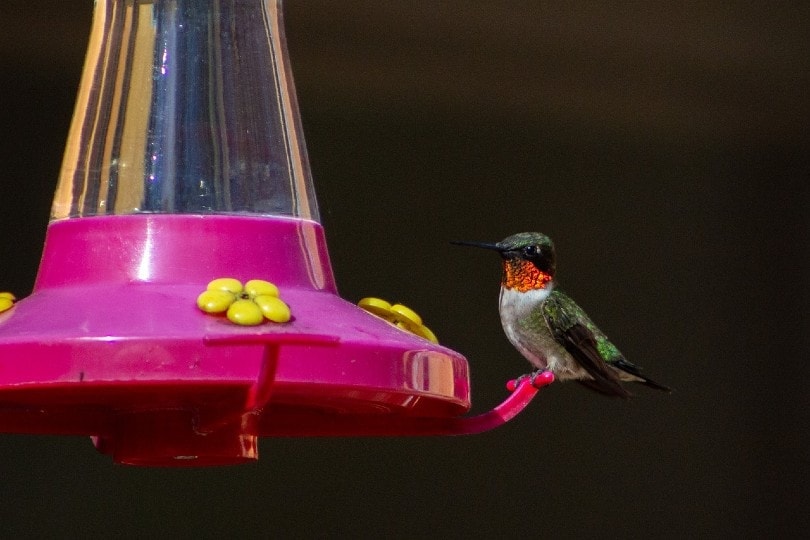
Install Multiple Feeders
Installing only one feeder is a bad idea because some members of the hummingbird community are very territorial and love bullying their counterparts. They’ll monopolize that one feeder, forcing everybody else to look for an alternative.
Grow More Nectar-Producing Plants
Especially the colorful kind. Hummingbirds usually rely on their color vision and not their sense of smell. Even if they are in a rush to get to their breeding grounds on the other side of the country, they won’t mind making a stopover, just to sample a few plant varieties.
The plants should also be native and able to attract insects. Hummingbirds prefer sucking nectar out of native plants, and the insects will act as a source of protein. The best flowers are sages, bee balms, and coral honeysuckles.
Provide Clean Water
Like humans, hummingbirds need water to stay hydrated and to clean themselves from time to time. You can serve the water in a dish, or with the help of a mister. For those who’ve never used it before, a mister is a tool used by backyard birders to shoot fine mist into the air. Hummingbirds really love it because they get to be sprayed with water midair, before heading back to their perch station to preen.
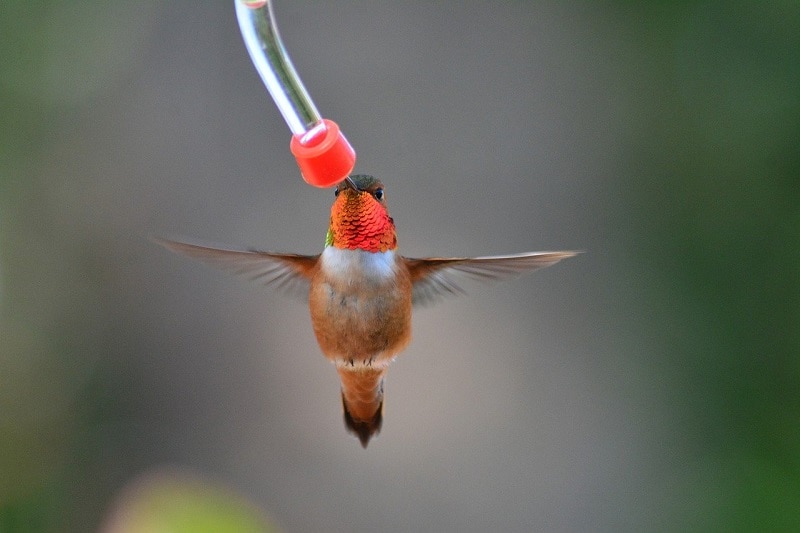
Make Your Backyard Nest-Friendly
Don’t remove those old spiderwebs if you’re looking to make your backyard hummingbird friendly. The webs are often used as raw material in the construction of miniature nests. Plant some shrubs and deciduous trees as well, to give your birds a nice sheltered area to raise their young ones.
Conclusion
Identifying the different types of hummingbirds can be difficult if you’re an inexperienced birder with limited knowledge of the ornithology world. So don’t beat yourself up if you’re struggling. Start by learning the simple stuff—for example, their striking colors—before moving on to the complex traits such as feeding, nesting, and social behavior.
Featured Image Credit: Sue Bishop, Shutterstock
About the Author Robert Sparks
Robert’s obsession with all things optical started early in life, when his optician father would bring home prototypes for Robert to play with. Nowadays, Robert is dedicated to helping others find the right optics for their needs. His hobbies include astronomy, astrophysics, and model building. Originally from Newark, NJ, he resides in Santa Fe, New Mexico, where the nighttime skies are filled with glittering stars.
Related Articles:
Monocular vs Telescope: Differences Explained (With Pictures)
8 Types of Hummingbirds in Nebraska (With Pictures)
5 Types of Hummingbirds in Idaho (With Pictures)
3 Types of Hummingbirds in Mississippi (With Pictures)
8 Types of Hummingbirds in Kansas (With Pictures)
5 Types of Hummingbirds in West Virginia (With Pictures)
5 Types of Hummingbirds in Ohio (With Pictures)
Where Do Nuthatches Nest? Nuthatch Nesting Habits Explained
